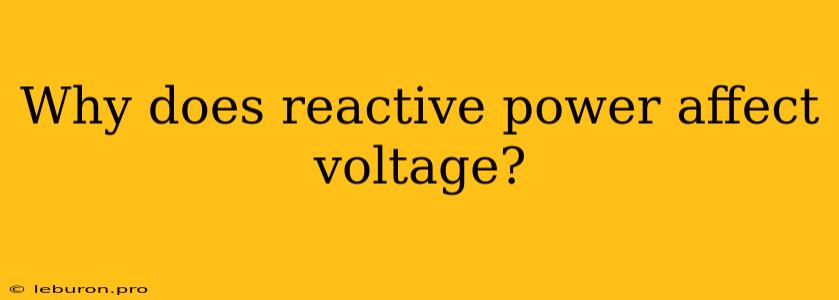Why Does Reactive Power Affect Voltage?
Understanding the intricate relationship between reactive power and voltage is crucial for efficient and reliable operation of electrical systems. Reactive power, unlike active power, does not contribute to useful work but plays a vital role in maintaining voltage levels within acceptable limits. This article delves into the fundamental principles governing this relationship, exploring the reasons behind voltage fluctuations caused by reactive power and discussing practical implications in power systems.
The Essence of Reactive Power
Reactive power, often symbolized as Q, is a form of power associated with magnetic and electric fields in alternating current (AC) circuits. It represents the energy stored in these fields, constantly oscillating between the source and load, without contributing to actual work. While active power (P) represents the power dissipated as heat or used for work, reactive power is a consequence of inductive and capacitive loads in the circuit.
Inductors and Capacitors: The Reactive Power Players
Inductors and capacitors, essential components in many electrical circuits, introduce reactance, which is the opposition to current flow in an AC circuit. Inductors, characterized by their ability to store energy in a magnetic field, create inductive reactance (XL), while capacitors, storing energy in an electric field, introduce capacitive reactance (XC).
Inductors store energy in a magnetic field when current flows through them. This stored energy is released back into the circuit as the current decreases, causing a phase shift between voltage and current. The phase difference, represented by a lagging angle, implies that the current lags behind the voltage, contributing to reactive power.
Capacitors, on the other hand, store energy in an electric field when voltage is applied across them. This stored energy is released as the voltage decreases, leading to a phase shift between current and voltage. The phase difference, represented by a leading angle, indicates that the current leads the voltage, contributing to reactive power.
Reactive Power and Voltage Drop
The interplay between reactive power and voltage is characterized by the phenomenon of voltage drop. This occurs due to the reactive power flow in the circuit, which can significantly influence the voltage level at the load.
Understanding the Impact of Reactive Power
When reactive power flows through a circuit, it creates a reactive current that, unlike active current, does not directly contribute to work. This reactive current flows through the circuit's impedance, which includes resistance and reactance. As a result, the reactive current leads to a voltage drop across the circuit's impedance, reducing the voltage available at the load.
Factors Contributing to Voltage Drop:
- High Reactive Power Demand: Loads with high reactive power requirements, such as motors and transformers, draw significant reactive current. This leads to a larger voltage drop across the circuit impedance.
- Long Transmission Lines: Transmission lines have inherent impedance, which increases with distance. Consequently, longer lines experience a greater voltage drop due to the reactive current flowing through them.
- High Impedance: Circuits with high impedance, resulting from factors like small conductor size or long lengths, experience a more pronounced voltage drop due to the reactive current.
Consequences of Voltage Drop
Excessive voltage drop caused by high reactive power can lead to several detrimental consequences in power systems:
Reduced Efficiency: Low voltage at the load leads to lower efficiency in equipment operation. Motors, for example, experience reduced torque and increased current draw, resulting in higher energy consumption and potentially overheating.
Equipment Malfunction: Some electrical equipment may malfunction or experience premature failure due to low voltage. Sensitive electronic devices are particularly vulnerable to voltage fluctuations, potentially leading to performance issues or damage.
Power System Instability: Severe voltage drops can destabilize the power system, leading to voltage collapse and blackouts. Maintaining stable voltage levels is crucial for reliable power distribution.
Addressing Reactive Power and Voltage Issues
To mitigate the negative effects of reactive power on voltage, various strategies are employed:
Power Factor Correction: This involves installing capacitors in parallel with inductive loads to compensate for the reactive power. Capacitors provide leading reactive power, offsetting the lagging reactive power from the load and improving the power factor.
Voltage Regulators: These devices automatically adjust the voltage output to compensate for voltage drops caused by reactive power. They can be used at various points in the power system to ensure consistent voltage levels.
Load Management: Optimizing the load distribution and reducing the overall reactive power demand can minimize voltage drops. This may involve implementing measures like energy-efficient equipment and proper sizing of transformers.
Conclusion
Reactive power, despite not directly contributing to work, plays a significant role in influencing voltage levels in electrical systems. Understanding the relationship between reactive power and voltage drop is essential for operating power systems efficiently and reliably. By implementing appropriate strategies to manage reactive power, such as power factor correction and voltage regulation, we can minimize voltage fluctuations, enhance system efficiency, and prevent disruptions in power supply.
